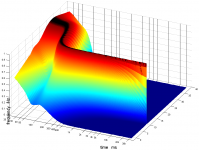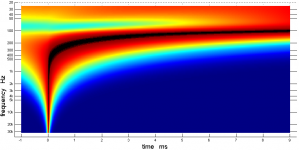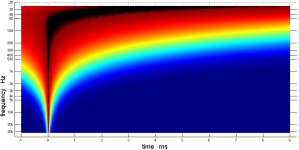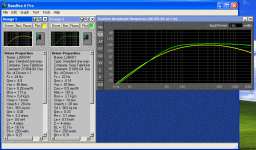Thanks Brytt for the comparisons and for showing the effect of a 48 db/oct crossover at 80 Hz. I'm not sure if the slope is LR or BW, JRiver don't allow you an option to specify the slope type. But it's clear what's causing the warp around 80 Hz...
...Today has been a gigantic waste. We got dumped with a foot of snow. I hate shoveling snow!
The standard high/low-pass in Jriver they are perfect IRR BW slopes and i know because have looped them back via SPDIF interface to check their precision curve presented into REW, so if you run one filter 48dB/oct its BW -3dB at XO point, and if you cascade two 24dB/oct gets you LR8 -6dB at XO point.
Regarding improving on APL_TDA experience try run execution-file from a thumb drive based on below note in their guide.
Good luck with weather : )
BYRTT has heard it, do I have fast bass? 😀 (sorry, I couldn't resist)
Well doesn't that explain itself "maximize below 1st plot" 😀 in same envelope harmonics above say 300Hz and up have already decayed when their father-tones below 100Hz hasn't start build up yet.
Own personal experience is admit A/B test with all-pass filters phase distortion above 1kHz is impossible to recognize but below 1kHz its some audio able especially over longer time listening session then the system setup with good timing gets one much more realism and closer to recording room.
Attachments
Last edited:
25 pcs Vifa just as wesayso, but in another enclosure.What kind of arrays do you have? Some pics would be great 🙂
Attachments
Here is a link to how they were made:
http://www.diyaudio.com/forums/multi-way/193015-stupid-cheap-line-array-21.html
http://www.diyaudio.com/forums/multi-way/193015-stupid-cheap-line-array-21.html
@wesayso.
Finally pulled myself together and took an impedance plot of my arrays .
The reference resistor was not non-inductive (47 Ohm // 1mH) therefore the drop in the top.
Have just ordered some 20 Ohm non-inductive, so stay tuned.
The plot clearly shows that the volumen is too small, which I already knew, as the dimensions of the alu-tubing couldn't be changed, but otherwise I think it is pretty clean.
No serious abrupt wrinkles, although there are some small and broad deviations.
What do you think?
I see nothing to worry about. Looking pretty good actually! That gives the FR a good chance of being even in response in that first wave front. Easier to correct with FIR filters as you have done. Audiolense right?
Simed so much time, and forgot, true 4th bandpass (with front chamber) is not interesting below 30-40hz in such configuration, nothing to gain. Efficiency gain is only around bandpass tuning low corner.
BMS12S305 8ohm measurements :
[Projet LCR] 2 voies BMS 12S305 _ RCF ND650 1.4" - Page 3 - 30074928 - sur le forum Enceintes - 1464 - du site Homecinema-fr.com
Lots of info. First graph is 1w, 25ms windows, closed 40L. Distortion plot is at 114db 400hz around 100w. 550hz hollow is plate vibration (seen on waterfall too). I just translate what is readen, and important.
Measurement download link : DL.FREE.FR
Thanks for that link, excellent info! I'm EQ-ing the measurements to see what can be done 😀.
These drivers do give me the impression of being targeted at mid-bass as the Car audio people call it. Will be potentially awesome for that kick in the chest.
Good to see this to know what to expect, see the group delay etc.
I'll run the impulse trough some FIR filters to see if that shows me useful data.
Excellent measurements to play with. Still making it hard to decide.
At 30 Hz distortion is down by ~27 dB. As soon as the level rises (+4.5 dB) it goes up. I don't expect this to be a referenced level though?
I can do better than 27 dB down with a single array at my seat:

(even more dB down in stereo, which is why adding woofers can even lower the current measured distortion)
This is my right channel as seen by the extra distortion at 30 Hz due to boost levels.
This level is true level according to my SPL meter from RadioShack.
Last edited:
At 30 Hz distortion is down by ~27 dB. As soon as the level rises (+4.5 dB) it goes up. I don't expect this to be a referenced level though?
As said :
Distortion plot is at 114db 400hz around 100w. 550hz hollow is plate vibration (seen on waterfall too).
And one speaker.
EDIT : waterfall at same level.
EDIT2 ADD :
114db at 400hz for 100w is exactly hornresp sim result (closed 40L 2pi). Based on that sim, 35hz level is probably around 102db.
So we can suppose distortion is down by ~27 dB @~102db @~35hz.
Now the good question to be fair is how does 1 way of your system compare (survive?) at 102db at 35hz ? 😉
Last edited:
Yes, but I'm looking at the single speaker measurements of the BMS at 30 Hz.
They need not do anything in the midrange in my application. I've hit well over 114 dB with the arrays too at the listening spot (almost 3 m away) in a raw measurement. It's the bottom end up to 100 Hz that needs the help due to various problems. Midrange is covered.
This one:

and the one 4.5 dB higher:

They need not do anything in the midrange in my application. I've hit well over 114 dB with the arrays too at the listening spot (almost 3 m away) in a raw measurement. It's the bottom end up to 100 Hz that needs the help due to various problems. Midrange is covered.
This one:

and the one 4.5 dB higher:

Last edited:
The midrange gets better (higher from the noise floor) though low end distortion goes up immediately.
I am planning to try REW/DRC as well.I see nothing to worry about. Looking pretty good actually! That gives the FR a good chance of being even in response in that first wave front. Easier to correct with FIR filters as you have done. Audiolense right?
But first I will try to use REW or APL-TDA to look for ways to tame my room and then experiment with all that window length stuff you have done.
I might need some help (a lot maybe🙂)
It's surprising, but i have a start of a explanation. Your inside (~1pi). Those measurement are said outside half-space (~2pi), and the guy seems to know well this kind of stuff. From hornresp, this give 10db in your favor of your system.
Still, sorry for the wrong track...
Still, sorry for the wrong track...
I am planning to try REW/DRC as well.
But first I will try to use REW or APL-TDA to look for ways to tame my room and then experiment with all that window length stuff you have done.
I might need some help (a lot maybe🙂)
I'll be here 😀.
It's surprising, but i have a start of a explanation. Your inside (~1pi). Those measurement are said outside half-space (~2pi), and the guy seems to know well this kind of stuff. From hornresp, this give 10db in your favor of your system.
Still, sorry for the wrong track...
Indeed, my room is helping, it will probably help the subwoofer too, though the room will also cause new troubles 🙂. I glanced at the things he was doing. I believe you. These measurements are very helpful.
The above measurement is from the right side array that isn't in a corner. The left does better at 30Hz and is in a corner.
It may be the wrong driver for me, it still is an excellent driver. In combination with the arrays and room, it could probably do what I want. But I guess so could the 30W. I have seen encouraging distortion measurements, though not in a box. The lower FS would move the impedance peak to around 40 Hz in a small enclosure with stuffing. Compared to higher up for the BMS. I guess in the real world that my needs would possibly be better suited to the lower Fs.
To match the array roughly in volume displacement would take about a 12" with 7mm x-max and 100 watt. So taking one with 12.5 mm x-max and 300 watt power reserve should win me at least 6 dB headroom to play with....
Together the array and woofer should be able to get what I have now while making it possible to back off a little with the low boost on the arrays (lowering overall distortion). No real answer until I try it I guess.
@wesayso - i bought a Xli800 for 12" JBL car subwoofer put in 60l sealed box.
The Crown is cheap but it has a fan (at this moment it is silent but running from power on..who knows after 1year if it will be silent?) and i think the input is not filtered RF because I have sometimes problems with noise it picks from computer (although at this moment i can't say exactly it is the Crown fault.. )
Thing have been moving so fast, hardly had the time to catch all posts 😉.
Thanks, I have experienced hum from hooking up my soundcard up to my A/B amp. It wasn't until I went with optical out to a DAC that it really cleared up. That's one thing I still fear, I only use a single stereo DAC connected with my soundcard trough SPdif, ambient channels are hooked up directly to the soundcard.
A ground isolator did help, but with EQ levels up they began to show saturation and this was seen as distortion in my measurements. Not sure how to overcome this hurdle. I'm sort of expecting to see the same results with sub amps.
I also noticed my cable antenna (in an unused but still connected receiver) could provide another source of hum. Without it hooked up my setup has been silent ever since that move to a separate DAC. The DAC hooked up to USB still had the same kind of hum. And showed less than stellar performance.
One of the things I still worry about.
Last edited:
If you are cool with Class-D, you should also look at Icepower. Very clean, very high damping factor, strong power supply. I really like them.
In my cave I used an old Crest pro amp because I needed the voltage output. It worked well, but was super heavy. Also a lot of loss in idle power.
In my cave I used an old Crest pro amp because I needed the voltage output. It worked well, but was super heavy. Also a lot of loss in idle power.
L26ROY / L26RO4Y. 2 layer copper voicecoil difference => different mms/qes...
Someone has got the spec wrong somewhere as both are different in Bassboxxpro to the SEAS datasheet. Both of the SEAS figures seem very high for drivers that don't roll off early. Most drivers with an Le that high would struggle to have much output above 500Hz.
But it does seem that the L26ROY is actually a better driver for a closed box.
These are the parameters bassboxxpro has for them.
The BMS woofers are aimed at sound reinforcement in a vented cabinet tuned between 35 and 40 Hz. They are really good at what they are designed for and can also be used in other cabinets but the specs make it harder for them to work as well.
Thing have been moving so fast, hardly had the time to catch all posts .
Thanks, I have experienced hum from hooking up my soundcard up to my A/B amp. It wasn't until I went with optical out to a DAC that it really cleared up. That's one thing I still fear, I only use a single stereo DAC connected with my soundcard trough SPdif, ambient channels are hooked up directly to the soundcard.
A ground isolator did help, but with EQ levels up they began to show saturation and this was seen as distortion in my measurements. Not sure how to overcome this hurdle. I'm sort of expecting to see the same results with sub amps.
I also noticed my cable antenna (in an unused but still connected receiver) could provide another source of hum. Without it hooked up my setup has been silent ever since that move to a separate DAC. The DAC hooked up to USB still had the same kind of hum. And showed less than stellar performance.
One of the things I still worry about.
Multi channel active setups can be a real pain for ground loops. My LX521 uses a Najda connected to a computer via usb with no isolation and then goes to an 8 channel UCD amp. Absolutely no noise whatsoever, no difference between optical or USB connection just silence.
The Orion setup with an outboard DAC and analogue crossover has terrible hum that is completely solved by connecting the DAC to the computer with an optical cable.
If you can use an optical cable that is the best way to break the ground loop. Transformers do the same but good ones are really expensive and even the best will cause roll off in the very low and high frequencies. Sometimes that can be helpful as an inbuilt RF filter.
Using a signal isolator chip on the USB i2s connection can break the loop without affecting frequency response and distortion but then they add jitter which needs to be removed by re-clocking so no free lunch their either.
Amps with separate power supplies for each channel help too but it is usually the combined signal ground in the preamp/DAC stage that sets up the possibility for loops particularly when all the components are safety grounded.
Signal cables need to be as short as practical to reduce the loop area. The other technique that is sometimes used is connecting 10 ohm resistors at the signal ground input, as the higher impedance can force the current to take a different path.
Optical SPDIF is the easiest solution if you can use it.
Attachments
If you are cool with Class-D, you should also look at Icepower. Very clean, very high damping factor, strong power supply. I really like them.
In my cave I used an old Crest pro amp because I needed the voltage output. It worked well, but was super heavy. Also a lot of loss in idle power.
Definitely also on my radar! As a poor boy I might have to run on a budget every now and then, it's pretty hard to wade trough it all and find the "good value for money". Luckily we can also get ahead by hard work in a lot of area's with simple tools and measures.
I'm not a fan of class D amp, especially for sub duty. Mind you, have never heard the Icepower amps, but I did hear some sub amps, like the plate amps, but D class, and they lacked "grunt".
I have to agree with the choice they made with the Nola Brio Trio, mentioning they much prefer the sound of AB amps.
On another note, look at where I'm going.... looks familiar? 😉
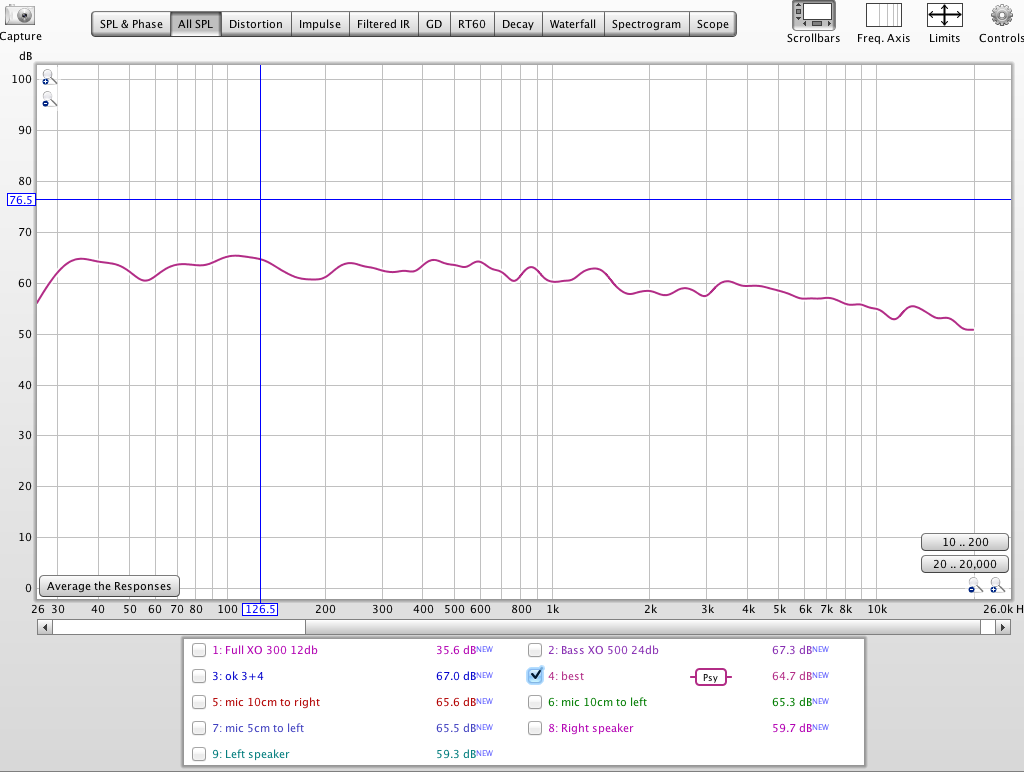
I have to agree with the choice they made with the Nola Brio Trio, mentioning they much prefer the sound of AB amps.
On another note, look at where I'm going.... looks familiar? 😉

I haven't heard class D, at least not consciously listened to one. I'm sure I've heard a few without knowing.
I've had a few in house on loan, honestly I was too scared to hook em up, afraid I was going to damage them.
So far class A/B with high bias class A does sound pretty good to my ears, mostly running in class A seems to work for these ears.
I'd love to try all of them, huge power hungry class A, First One, First Watt, the big A/B amps, NCore... Who wouldn't?
Great stuff Perceval! I assume this is your Brio Trio Plus size?
I've had a few in house on loan, honestly I was too scared to hook em up, afraid I was going to damage them.
So far class A/B with high bias class A does sound pretty good to my ears, mostly running in class A seems to work for these ears.
I'd love to try all of them, huge power hungry class A, First One, First Watt, the big A/B amps, NCore... Who wouldn't?
Great stuff Perceval! I assume this is your Brio Trio Plus size?
Last edited:
Damn, that was fun... I managed to derail a thread by trying to help someone. I should learn, when do I ever. Only days ago I used a picture in a PM describing the 'fanatism' I have for this hobby (if it isn't a word, it is now, ok?).
But right now I really feel I really belong there... for falling into that trap.

Anyone want to join me?
But right now I really feel I really belong there... for falling into that trap.

Anyone want to join me?
- Home
- Loudspeakers
- Full Range
- The making of: The Two Towers (a 25 driver Full Range line array)
